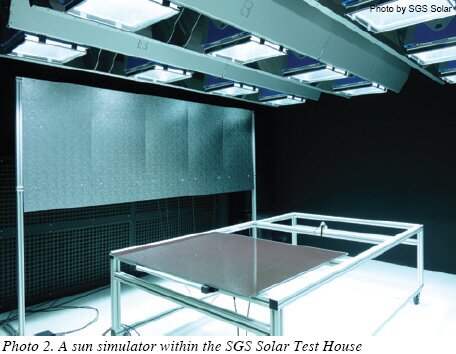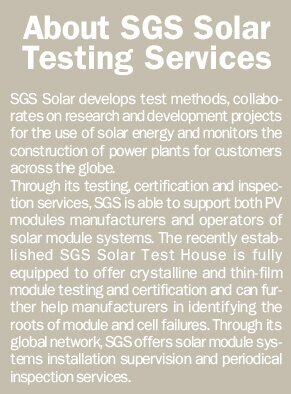Accelerated solar module qualification processes seriously reduce ¡°Time-to-Market¡± for solar manufacturers.
Photovoltaic (PV) module manufacturers have reason to be optimistic about the fast growth of their business. In the past, many of them have had to queue at solar test institutes, waiting for months before testing of their module could begin. But now queue times have been significantly reduced due to the emergence of a high number of solar testing labs, and with it the strengthened position of manufacturers. Thus, the transition period from prototype product to full production has considerably shortened, hence accelerating Return on Investment (ROI).
By Jorn Brembach

 Photovoltaic (PV) systems represent an environmentally sound, robust, reliable, and thoroughly tested technology, complete with a long lifetime. Although upfront capital costs are considerable, subsequent operation and maintenance costs are relatively low. Furthermore, investments in PV are offset through reductions in electricity consumption of the installation to which the system is connected, and through direct sales of the entire energy production to the utility. Photovoltaic (PV) systems represent an environmentally sound, robust, reliable, and thoroughly tested technology, complete with a long lifetime. Although upfront capital costs are considerable, subsequent operation and maintenance costs are relatively low. Furthermore, investments in PV are offset through reductions in electricity consumption of the installation to which the system is connected, and through direct sales of the entire energy production to the utility.
The economic viability of a PV system over its lifetime is conditional in part on the initial attention to and appropriate consideration of the specific physical requirements of solar cells and solar modules with respect to parameters such as tilt angles, operative temperatures, shadow-makers, mechanical load and other conditions. This requires expert knowledge to assess both the economics of a new project and the remaining lifetime of a PV system.
Stable Industry Growth
As a consequence of the ongoing growth, the cost-effectiveness of PV systems is increasingly gaining importance. Investors often draw more attention to the profitability of the investment rather than focus on ecological benefits. The main parameters which affect the investment¡¯s profitability are capital cost, compensation and economic life-time of the system components. Thereby, the payback time of the whole system is mainly determined by the initial power output, power degradation and the lifetime of the module. The PV-modules¡¯s guaranteed and certified quality is hence a fundamental requirement providing the basis for the investment¡¯s profitability and security.
As the quick expansion of the PV industry, with more than 750 photovoltaic module producers worldwide, has led to constant improvements in modules and materials, the need for module qualification is growing. Until recently, the waiting times for laboratory quality tests were long, as existing capacity was too small for the efficient handling of huge levels of demand. On average, module testing and certification could take eight months or longer.
All this now seems to have changed and module qualification has gradually become a buyer¡¯s market. This is due to several testing and certification big names building PV testing laboratories and the gradual extension of capacity at existing institutes. Now, there is enough capacity to cover the needs of the market and this significantly benefits PV manufacturers.
Faster Quality Testing
As more and more solar module qualification labs appear and fight for a share of the market, PV manufacturers have found themselves in a stronger position. This is great news, because every month PV manufacturers spend on module qualification means a delay to their product launch, which in turn means a loss of revenue.
At the same time quality testing is essential at this stage; if design flaws are not identified and remedied before the product¡¯s launch on the market, a manufacturer¡¯s reputation can be crippled, endangering their entire business. This is why the competition between testing institutes is focused on offering high quality testing and the shortest possible qualification times. If PV module qualification would previously have taken the better part of a year, today Solar institutes offer certification times ranging between 4 and 6 months. Testing labs are now on the verge of offering the shortest module qualification times possible, which are determined by the complex set of tests required by PV modules standards.
Even though the transition from prototype product to full production is challenging enough, minimizing the risk of faulty modules is, however, as important as cutting qualification times.
Specific Needs of PV Module Manufacturers: Bankability
The intense competition between PV module manufacturers motivates many to request certifications that go beyond the existing standards. To ensure that their innovations in materials are successful, manufacturers are increasingly requesting certifications that cover energy output, material qualification, equipment appraisal and production quality management. Ultimately their goal is to produce high quality PV modules and increase their market share by achieving and fulfilling bankability guidelines.
The major developments happening in the PV modules¡¯ testing and certification market already seems to be having a positive effect on the industry¡¯s growth. To satisfy even the most complex testing and certification requirements, testing institutions such as the SGS Solar Test House shown in Photo 1 offer service packages that can be customized to suit all the specific needs of PV module manufacturers. Hence, the institutions¡¯ offer is often extended by quick tests without the clients needing to wait and a time-dependent price structure.
An additional advantage for manufacturers in this area is the combination of testing capacities with experience in the semiconductor industry. Therefore, the entire quality control and analysis needs of the industry innovators--from raw materials to solar cells and modules--can be covered in a one stop Quality Assurance Services bundle. In accordance with globally effective PV standards, the manufacturer can order failure analyses (e.g. for silicon wafers), down to microscopic levels that employ high precision equipment to perform atom-level surface analyses, element depth profiles and identification of impurities and contact problems.
.jpg)

Necessary Electro Technical Standards
Currently, there are more than 750 photovoltaic module producers worldwide, and the testing demand for new materials and techniques is growing. The IEC standards are necessary for PV module manufacturers to promote and sell their products.
The first standards for solar modules are the result of research institutes¡¯ work, especially the European Solar Test Installation (ESTI) lab in Ispra, Italy. The lab began certifying solar modules almost 20 years ago, based on their own standard called Ispra 503. Eventually this standard was used by the International Electro technical Commission (IEC) as the basis for the crystalline modules standard--IEC 61215 and later on the thin-film modules standard --IEC 61646.
The qualification procedures defined in IEC 61215 aim to characterize the module before and after exposure to different types of stress. This is done by a visual inspection, testing of insulation and measurement of performance. To pass the test, the modules have to meet the following criteria:
-No visible evidence of major defects that may affect the performance of the modules.
-Insulation resistance not less than 50M¥Ø at 500 V d.c
-Degradation of performance may not exceed 5 % after each single test or 8 % after the whole sequence.
According to these standards, modules that pass the required test are considered able to function properly for 20 years in a moderate European climate.
Slight Differences for North America
As Canada and the U.S.A. do not fully accept IEC 61730 for product safety, PV modules destined for these markets need to follow the local UL 1703 standard for electrical safety. For PV modules the major difference between the two standards is that UL 1703 also requires a fire test, during which a module is set on fire to envisage how the fire will spread based on the composition of module cells.
Furthermore, certification to UL 1703 can only be performed in the U.S. or Canadian labs accredited by the Occupational Safety and Health Administration (OHSA). Harmonization of the IEC and UL electrical safety standard is a constant topic of discussion both within the industry and between governments, but there is little chance of it happening soon.
However, in February 2010, the Solar America Board for Codes and Standards recommended the adoption of IEC quality standards for all modules purchased in the U.S. marketplace. The aim of this initiative is to improve the quality and reliability of the photovoltaic technology in the U.S. marketplace.
This effort takes initial steps in providing a foundation for the protection of consumers and businesses alike from unknowingly buying poor quality photovoltaic modules, including those rejected by testing and certification officials in other countries. Both the European Union and Asia already require this testing on all photovoltaic technology sold in their markets.
This is a first step in developing a sustainable marketplace for renewable solar technologies. It is in the market¡¯s long-term best interest to take basic steps to prevent poor quality solar energy equipment from flooding the U.S. market.
Tough Sequences of PV Modules Testing
The standards are not an absolute guarantee that modules will operate failure free for 20 years, but they certainly increase the possibility.
The Conceptual Phase
The range of qualification services offered throughout the project life cycle minimizes the total risk of a manufacturer¡¯s PV project. Subscribing to the logic that the earlier risks are detected, the earlier effective countermeasures can be implemented, some PV testing laboratories engage in projects starting at the Conceptual Phase. During this stage, services such as Design Verification, Technical Due Diligence, Tender Support and Feasibility Studies help minimize both cost- and time-related risks during project development and ensure ideal power performance. Specifically, the Design Verification and Site Assessment activities comprise an estimate of the expected annual energy production through the use of computer simulation such as the sun simulator displayed in Photo 2.
In parallel, testing laboratories can verify the combined environmental cases relevant for the PV systems, which include the impact of variables such as temperature, rain, hail, snow, corrosion, dust, lightning, horizon and near-shadow effects. Verification of the design and site conditions also includes the following activities:
-Assessment of layout and design for construction and electrical installation
-Assessment of quality of system components and installation
-Assessment of quality of documentation, operation and maintenance instruction
The Manufacturing Phase
The Manufacturing Phase is an equally critical stage of project realization. At this time, regular inspection visits of the different manufacturers are performed to assure quality during production of components. An inspection can include assembly checks, material testing supervision and Non Destructive Testing (NDT). This begins with a pre-production meeting to establish the inspection and test plan as well as supervision of test runs of electrical and mechanical components.
Crystalline and thin-film modules certification includes some rather tough sequences of tests, designed to simulate the range of climatic conditions in which solar modules will have to operate over long periods of time. Most testing is performed in climatic chambers and includes:
-Damp-heat test - modules are exposed to temperatures of 85¡ÆC, with 85% relative humidity for 1000 hours
-Temperature cycling test - the temperature in the climatic chamber cycles back and forth between -40¡ÆC and 85¡ÆC over 200 times
-Humidity-frost test - temperatures change in the climatic chamber as in the previous test but at an 85% relative humidity
-Hot spot test - a module is exposed to light, with several cells shaded
Crystalline modules that lose more than 5% of their power in any single test or more than 8% after a series of tests are failed, ensuring that manufacturers must make improvements before testing again. Modules that show highly visible changes, such as delamination, also fail the test procedure. Data from various solar institutes shows that on average one third of crystalline modules and half of all thin-film modules fail the first series of tests. After identifying the cause and making improvements, the large majority of modules receive certification.
Certifying the Investment
Although voluntary, module certification has become a must for PV manufacturers, as buyers want to make sure their substantial investment is worth it and will pay off over time. The importance of certification is reflected not only by the high number of certifications sold in Europe and the U.S.A. but also by the growth of the module qualification business in Asia.
Certification standards are constantly being reviewed in industry working groups to improve testing requirements that eventually lead to more efficient modules. The third edition of the crystalline modules standard will most probably be published this year and updates to the thin-film module standard are currently under discussion.
Certification of solar systems benefits manufacturers, contractors, consumers, and government agencies by establishing credibility and acceptance. Standardized methods for measuring product performance and durability as well as certification standards serve as a rational basis for qualification for tax credit programs and help manufacturers to produce high quality PV modules and increase their market share through an increase in good reputation. The manufacturer¡¯s initial investment can, thus, be made both profitable and secure.
Although solar module qualification consists of some very tough tests that challenge manufacturers to do their very best, the future of this industry seems to be very bright.

Jorn Brembach joined the leading testing and certification company, SGS (www.sgs.com/ solar) in 2003. As Business Manager in Photovoltaics, he holds the civil engineer degree as well as an Executive MBA.
For more information, please send your e-mails to pved@infothe.com.
¨Ï2010 www.interpv.net All rights reserved. |


